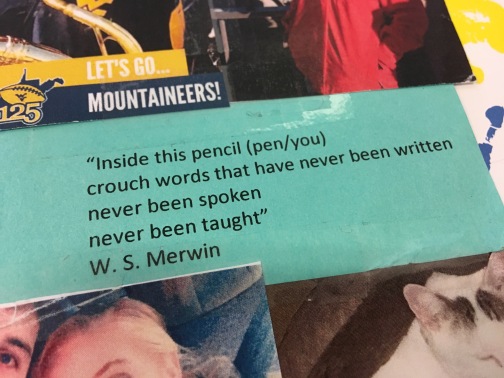
This weekend, I spent some time reading and responding to my students’ Teacher-Researcher Notebooks. These TRNs, my preservice teachers’ versions of the writer’s notebook, are where my college students’ thinking about their learning, teaching, students, and growth intersect.
Their notebooks inspired me–so much so that I began making a list in my own notebook of all the techniques and sketches and thoughts I saw so I could utilize them myself. I saw some ideas I’d given them, based on what’s in my own notebook, but I also saw some fresh genres that were new to me.
These five excerpts from my students’ notebooks illustrate that when given the choice afforded by workshop’s emphasis on frequent, low-stakes writing, balanced with the structure of routines, mentor texts, and feedback, the writer’s notebook is a powerful tool in any teacher’s arsenal. I’ll share them in the hopes that you and your students will try them out, too!
Orientation Pages. Making lists of writing territories, drawing heart maps, or tracing your hand like Penny Kittle often does are great ways to orient yourself in your notebook. I often ask students to do this both at the beginning of the semester, when our notebooks are fresh and empty, as well as periodically throughout the year to orient ourselves.

These “orientation pages” center us, remind us who we are and what’s important to us, and double as a handy list of writing topics when we don’t know what to write. I love how Kourtney blended this technique with what she was noticing in her students.
Artifacts. Glue-ins not only serve to remind us of a particular time or place, but also act as inspiration for future writing. Many of my students glued in their name badges from their schools last year–a tangible marker of time’s passing that helped them see how much closer they were to becoming “real” teachers.

I love that Megan glued in her Tutor badge–she’s graduated to a Participant this year, and will be an Intern next year–and how faded it is. She also glued in a final feedback note I gave her after she presented her end-of-semester research project last year. Her title “Things That Keep Me Going” is a handy thing to have around when the stress of teaching gets to be a little much.
Imitations of Mentor Texts. Like many of my Twitter friends, I am obsessed with the lovely and poetic Mari Andrew. Her art serves as a frequent mentor text for my students, and we studied this image about how we define our passions, and they don’t define us–then imitated it.

I love Julie’s illustration, which shows not only how many “Julies” she is beyond just teacher Julie, but also serves as inspiration in the form of an orientation page and a source for high-interest lesson topics she might pull in when she’s searching for some imaginative planning ideas.
Quotes. We learn so much from studying others’ words, not just for their message, but for their craft. Gluing in quotes, poems, essays, emails, and other bits of writing inspires us, teaches us, and motivates us to put pen to paper in ways that are meaningful.

This quote Cat glued into her notebook is a wonderful one that I copied down myself, the better to write around, be inspired by, and imitate. It’s an apt metaphor for both teachers and writers, and served for Cat as a reminder of her potential and power as a blossoming educator.
State of the Writer. I urge my students to pause every two weeks or so and create a “big-picture entry.” This could involve doing a little reflection about themselves, looking at the undercurrents of what’s going on in their teaching, synthesizing some of the learning they’re doing in their classes, or a combination of those.

I love that Elizabeth chose to do a little sketch of herself surrounded by the myriad thought bubbles typical to a teacher’s brain. Lesson planning, fretting about money, digesting Freire’s Pedagogy of the Oppressed, and the black hole of Pinterest…I mean, how spot-on is this!? I’d love to use this as an alternative to a written quarterly reflection with high school students to illustrate the intersections between who we are and what we’re learning.
Will you share some of your students’ notebook wisdom with us? Tell us about what your students write in the comments, or using the hashtag #whatsinanotebook on Facebook and Twitter!
Shana Karnes is mom to 1.5 spunky little girls and wife to a hardworking surgical resident. She teaches practicing and preservice English teachers at West Virginia University and is fueled by coffee, a pregnancy craving of Honeycrisp apples (this week), and a real obsession with all things reading and writing. Follow Shana on Twitter at @litreader or read more of her writing on the WVCTE Best Practices Blog.

This sucks LOL
LikeLike
[…] all the years of my teaching career, my students have always kept writer’s notebooks. We personalize our covers and create our own book lists and dictionaries, practice writing, […]
LikeLike
[…] that hesitation that I have in order to better help my students. I’m so enamored by posts like Shana’s that show just how powerful Writers Workshop can be, so I am pushing past my awkwardness. […]
LikeLike
[…] Follow Shana on Twitter at @litreader and read more of her writing at Three Teachers Talk, where a version of this post first […]
LikeLike